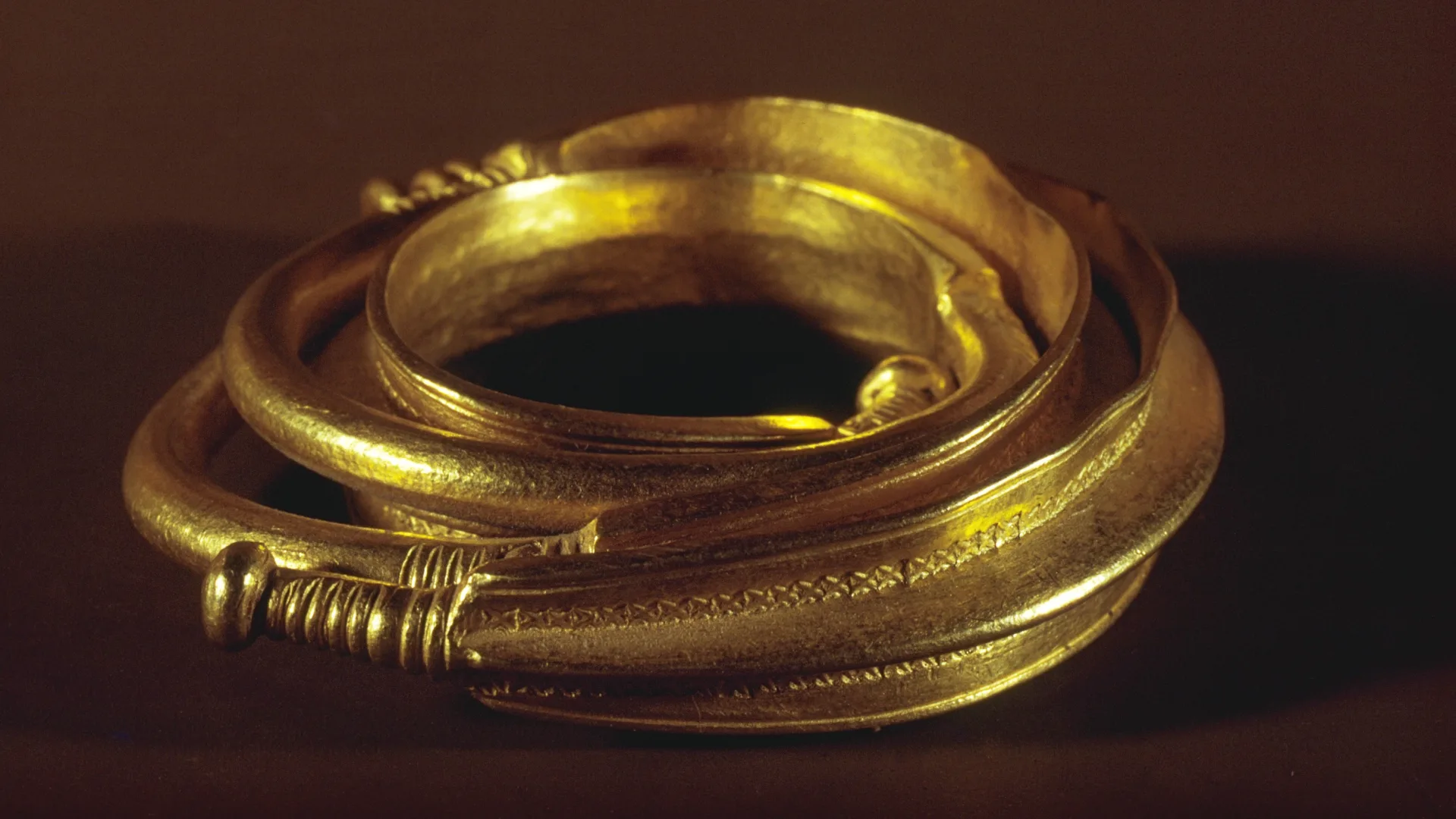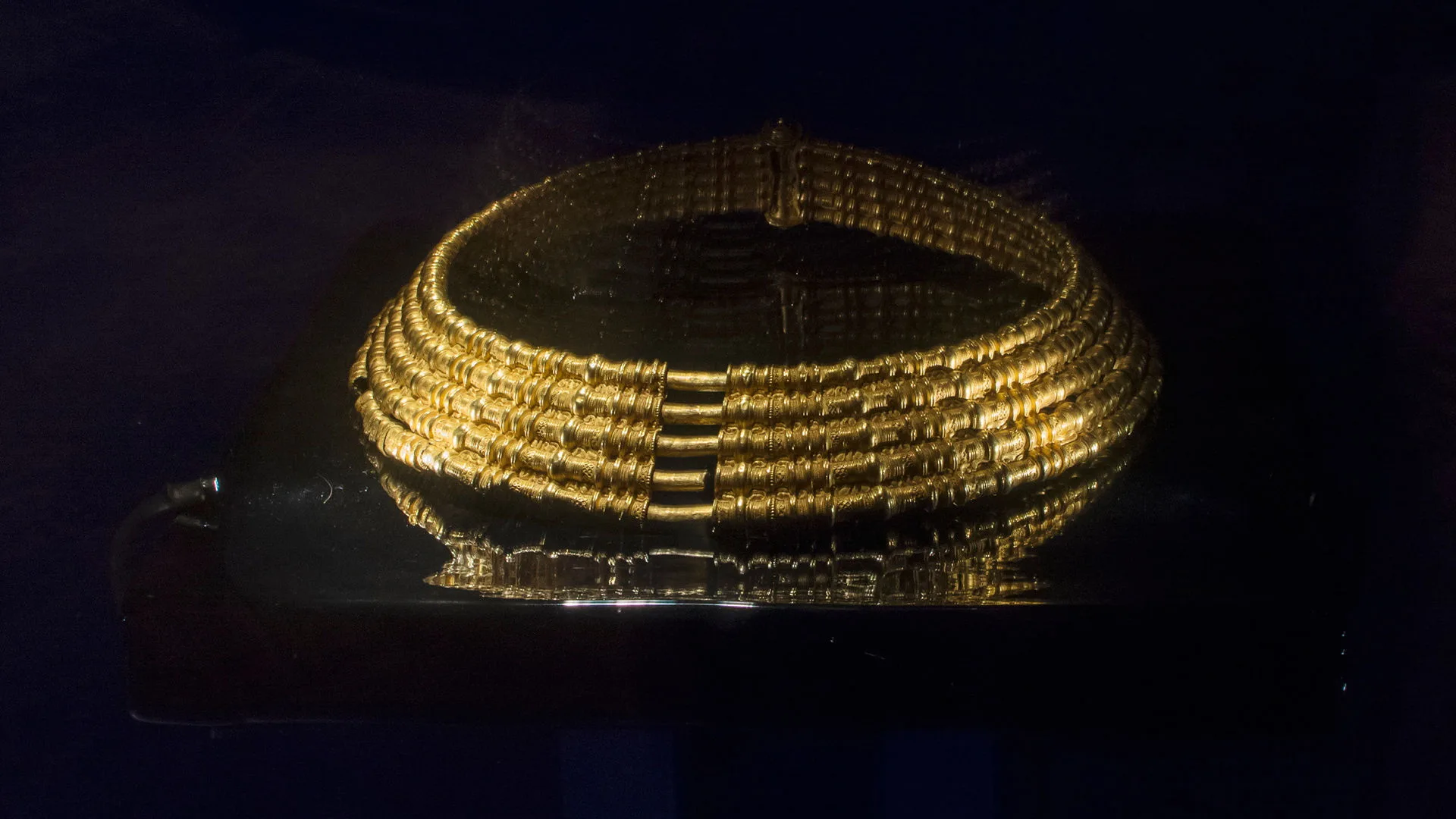Intro to the Nordic Bronze Age
Stone Age
12,000 BC – 1700 BC
Bronze Age
1700 BC – 500 BC
Iron Age
500 BC – AD 1100

Nordic Bronze Age in Southern Sweden
The Bronze Age got its name because people began using copper and tin to make weapons, tools, and jewelry. Bronze is a mixture of about 90 percent copper and 10 percent tin. The oldest objects could be made solely of copper, but soon people discovered that the objects became better when the metals were mixed during casting.
All the copper and tin was imported from Central and Southern Europe or from the British Isles. Several tons of metal were transported to Sweden each year, both over water and over land. The transports could stretch over 2,000 kilometers.
The need for a steady supply of metal meant that people had close contacts over great distances. The Bronze Age in Scandinavia showed many similarities with other contemporary cultures in Europe and around the Mediterranean. At the same time, metal craftsmanship reached very high levels in Scandinavia, and fantastic decorations were created here.
Much of the bronze was used for tools, jewelry, and weapons. Some objects, such as large bronze lurs (musical instruments), cult axes, and figurines, were made for use at festivals and rituals.

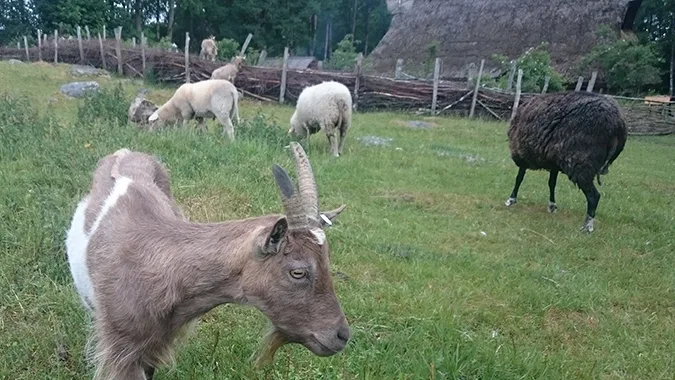
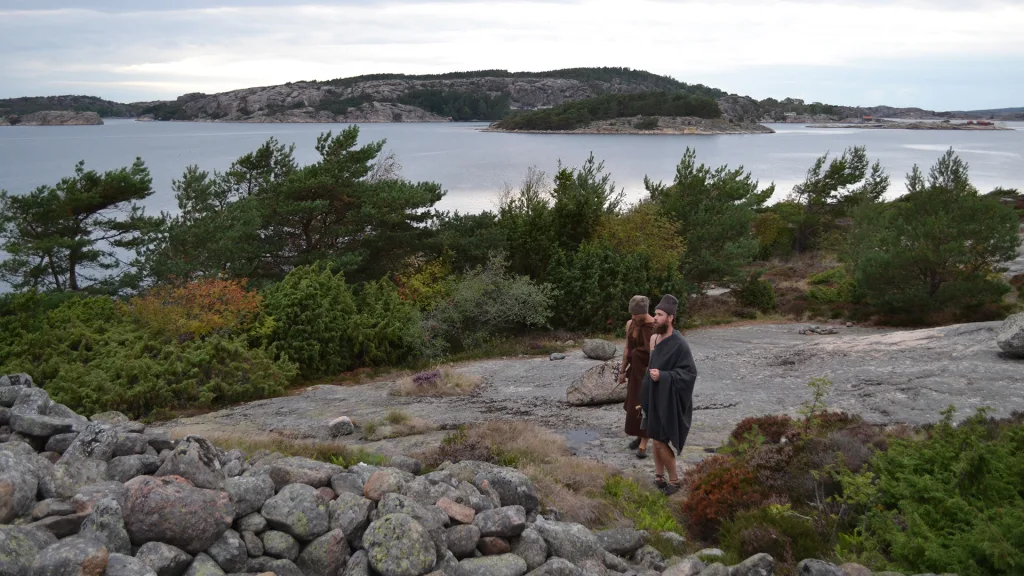
Reconstruction of what life could look like in the Bronze Age. From Vitlycke, Sweden during the film shoot for Arkeologens dotter (UR, 2018). Photo: Linda Wåhlander, The Swedish History Museum/SHM.
Most people in southern Sweden during the Bronze Age were farmers and herders. They cultivated wheat and barley and kept cows, sheep, goats, pigs, and horses. They were settled and lived in longhouses made of wood, reeds, and clay. During the early Bronze Age, large mounds or cairns were built over powerful men and women. Often several people were buried in the same grave, and usually the dead were not cremated.
There are no written sources from the time, so everything we know comes from archaeological investigations. In addition, studies of the landscape, climate, and agriculture have been made possible through pollen analyses of peat layers in wetlands.
Bronze lur – a Bronze Age instrument
Large Bronze Age lurs are depicted on several rock carvings. Sometimes the lur players in the carvings are shown wearing horned helmets. This bronze lur was once wrapped in birch bark and was found in a bog at Påarp in Västra Karup parish, Skåne. It was cast in three parts with decoration of ridges and concentric circles. Originally, the lur was even longer, with a mouthpiece and a section ending in a flat bell. The lur is dated to 900–700 BC. The small holes visible on the lur are traces of the casting supports that held the mould sections apart. The supports have since weathered away.
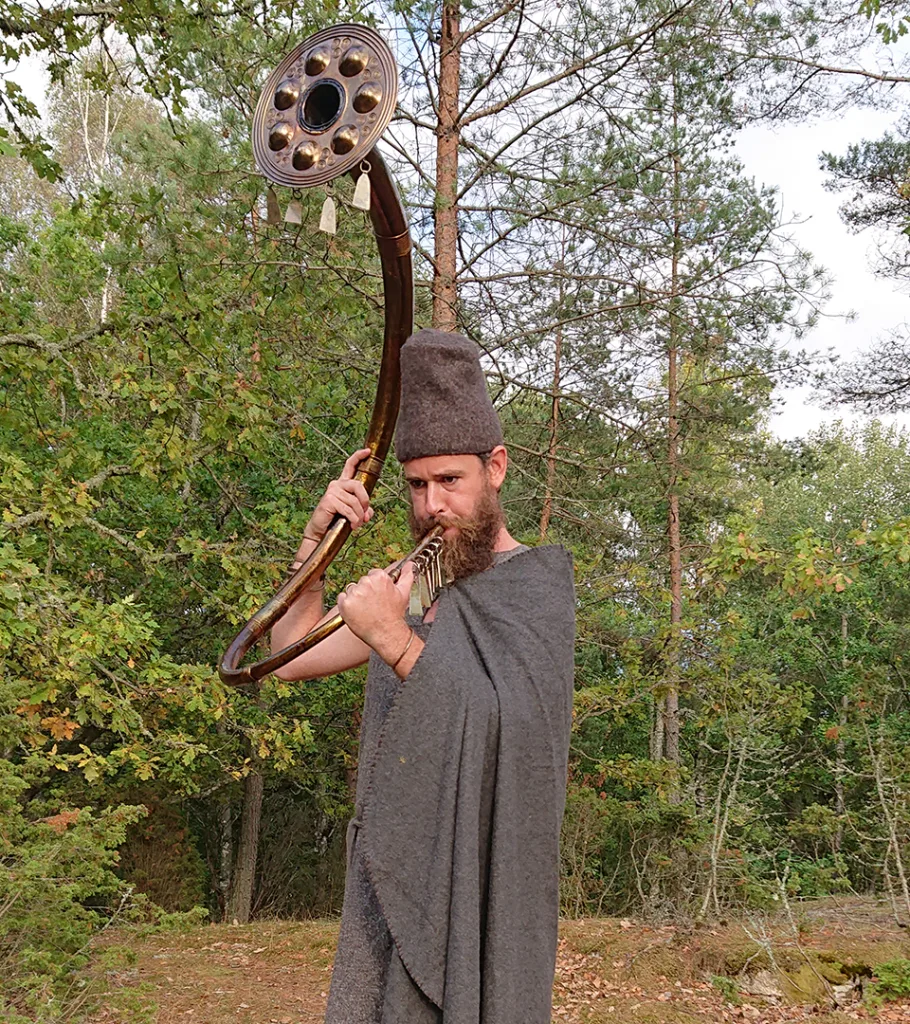
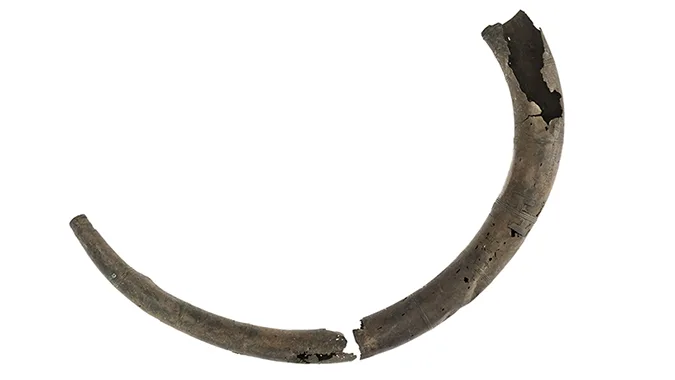
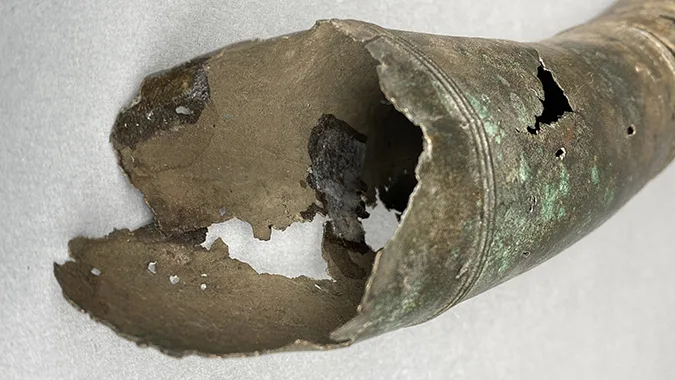
Left: Reconstruction of how a bronze lur was played. From Vitlycke, Sweden during the film shoot for Arkeologens dotter (UR, 2018). Photo: Linda Wåhlander, The Swedish History Museum/SHM. Right: A bronze lur from the collections. Photo: Helena Bonnevier, Camilla Hällbrink, The Swedish History Museum/SHM (CC BY 4.0).
Late Nordic Bronze Age in Southern Sweden
The period between 1100–500 BC is called the Late Nordic Bronze Age. New influences arrived from the Continent, and people began to cremate the dead before burial. Burnt bones were often placed in a pot and in a few cases, the pot was shaped like a small house or a stylised face.
Grave goods became simpler, most often just a razor, tweezers, or a dress pin. It is difficult to see any clear chieftain class from the burial customs, but social differences probably existed. Instead, burial grounds were established where stone settings marked the graves. The era of the great burial mounds was over.
Now, large collections of bronze objects were deposited in water or on dry land. Archaeologists usually refer to such finds as hoards. Sometimes they were stores of bronze intended for recasting, but often they were offerings to gods or nature spirits.

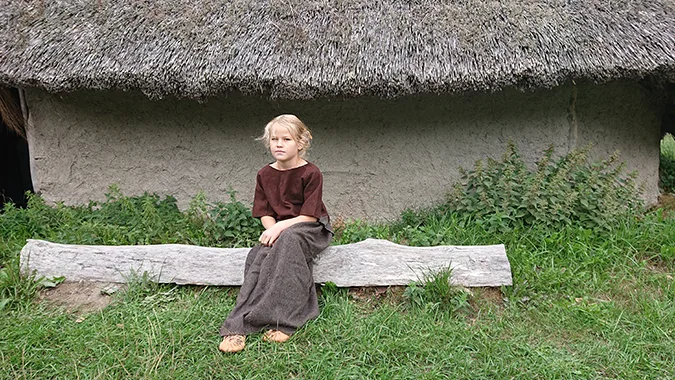
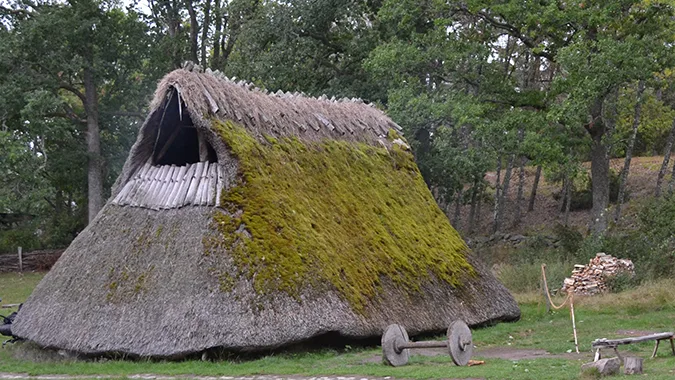
Reconstruction of a Bronze Age village. From Vitlycke, Sweden during the film shoot for Arkeologens dotter (UR, 2018). Photo: Linda Wåhlander, The Swedish History Museum/SHM.
Towards the end of the Nordic Bronze Age, jewellery grew larger and displayed magnificent decorations of spirals, rows of dragons, and meander patterns. Neck rings were a common type of ornament, often associated with women, though they also appear in men’s graves.
Objects were cast at most settlements across the country, and crucibles and moulds are common finds. The finest items show that they were made by true master casters.
Pottery was used at feasts and rituals and was inspired by contacts with Central Europe. People used finely polished bowls with handles for eating and drinking. Food, mead, and beer were kept in large vessels with a rusticated surface.
There are signs that iron was beginning to be known during this period, but it was still a rare metal.
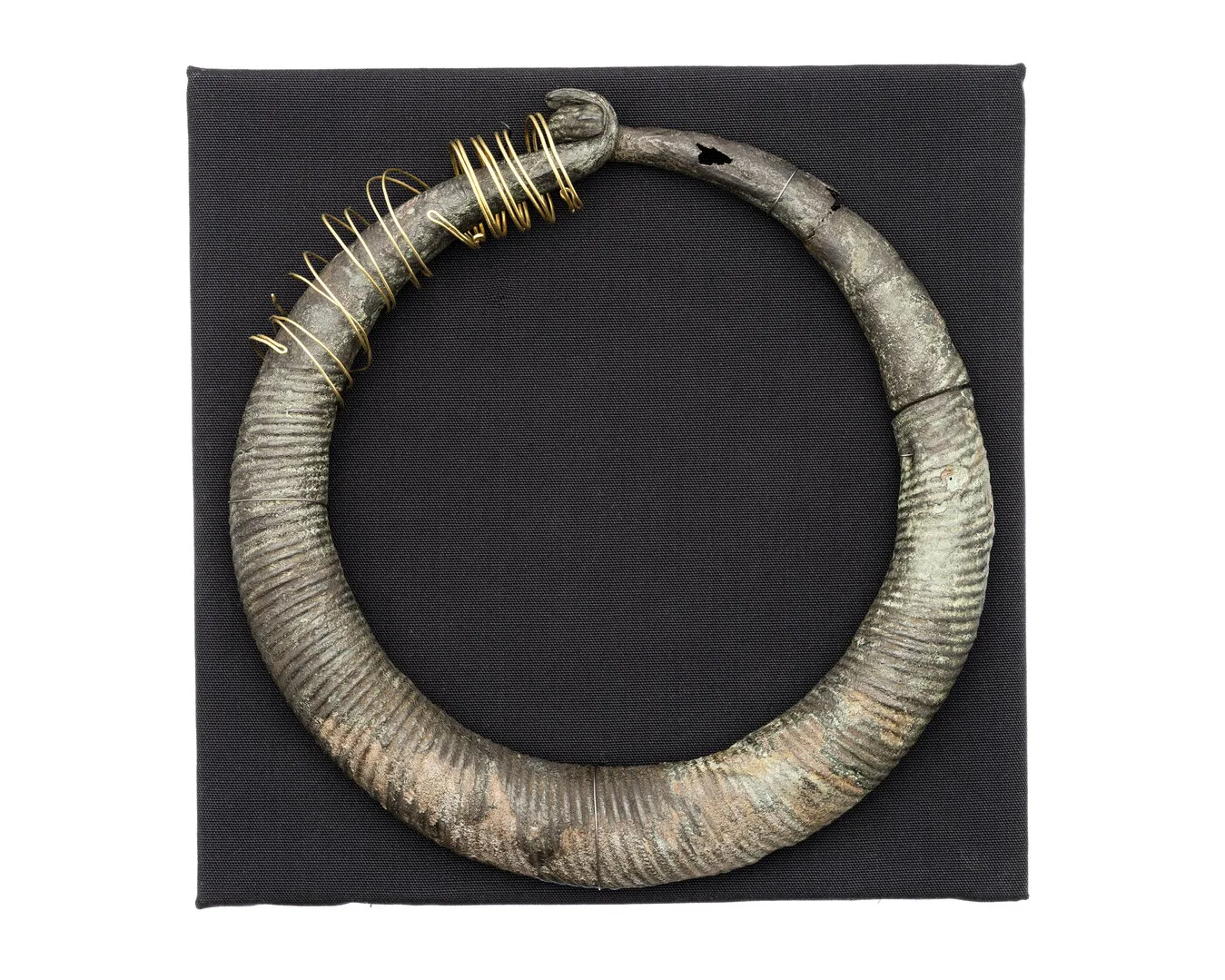
Neck ring with gold spirals
From Scandinavia, 1300-900 BC
On view at Ekonomiska museet - Kungliga myntkabinettet in the exhibition Pengar!Find this object in display 2A & 2B, Flintdolkar och ringar
Nordic Bronze Age in Norrland and Dalarna
Prehistory in the inland areas of Norrland and Dalarna was very different from the areas south of the Dalälven River, meaning most of Svealand and Götaland. However, there were some southern influences and settlements similar to those in southern Sweden along the coast and in the river valleys.
We do not know which peoples lived in the north or what languages they spoke, but their economy and material culture were different from those in the south. Many features in the north had more in common with prehistoric cultures in what is now Norway, Finland and Russia than with the cultures of southern Scandinavia.
Hunting and fishing were crucial for survival in the inland areas. For example, there are large systems of pit traps used to catch big game. These pit systems have been dated to about 4000 BC, but they seem to have become more common and larger during the Bronze and Iron Ages. They were used to catch moose and reindeer, providing antlers, meat and furs.
The people were partly nomadic, but there were also larger gathering sites for meetings or more settled living. Rock carvings and rock paintings in various places show that the moose played an important role both for survival and in beliefs or rituals.

One of the most famous and largest sites with rock carvings and settlement remains is at Nämforsen in Ångermanland. Many of the carvings were made already in the Stone Age, but some designs – for example the boat carvings – may be from the Nordic Bronze Age.
Finds here include pieces of skis and wooden sledge runners, showing that people used skiing and sledges during winter.
Pottery was used, and it was often tempered with asbestos. Tempering means mixing something into the clay so it dries better and can handle heating. In southern Sweden, people mixed the clay with crushed granite instead. The asbestos made the pots very strong, light and resistant to bumps. Today we know asbestos is dangerous to health, but back then people thought its advantages were greater than the risks.
Using asbestos in pottery was common in large parts of Norway and Finland during this time. The pots could be decorated with raised bands, stamped patterns and pits. Most of all, people pressed different materials into the surface, giving the outside of the vessels carved or waffle-like patterns. These styles were common in the far north of Europe and Asia.
Many tools were still made from stone, such as slate and quartzite. The polished slate tools and shaped quartzite points could be very elegant. During the later Bronze Age, people in Norrland also began casting their own bronze objects. The socketed axes they made looked similar to those in northern Norway, Finland and Russia.
Along the coasts there are also bronze finds and burial cairns of south Scandinavian style. Outside Umeå, archaeologists have found a settlement with houses and pottery similar to that in southern Scandinavia, mixed with asbestos pottery. The climate was slightly warmer in the Bronze Age than in the Iron Age, and grain farming also took place in the north.


